- 신생아 심폐 소생술 Neonatal cardiopulmonary resuscitation(Neonatal CPR)
숨을 거의 못 쉬거나 갑자기 심장이 정지된 상태에 있는 신생아를 소생시킬 수 있는 기본 심폐소생술을 여기서 설명한다.
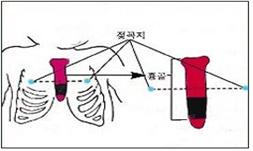
그림 2-98. 신생아 심폐 소생술을 할 때.
검은 색으로 표시된 흉골 부위를 손가락으로 눌러 심장 마사지(심장 압박술)를 한다.
Use with permission from the Textbook of Neonatal Resuscitation. 1987
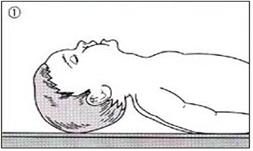
그림 2-99. 갓 태어난 신생아의 심폐 소생술을 할 때 단단하고 평평한 자리에 등을 대고 눕힌다.
Use with permission from the Textbook of Neonatal Resuscitation. 1987
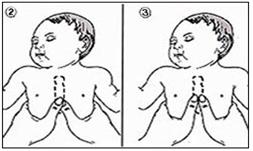
그림 2-100. 아기의 흉골 아래 부위에 양쪽 엄지손가락을 그림과 같이 겹쳐놓거나 나란히 올려놓고 나머지 손가락으로 아기의 몸통을 싸잡고 심장 마사지(심장 압박술)를 한다.
Use with permission from the Textbook of Neonatal Resuscitation. 1987
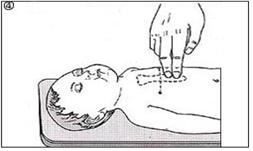
그림 2-101. 집게손가락과 가운데 손가락의 끝 부위를 그림과 같이 흉골 아래 부위에 올려놓고 신생아의 앞가슴을 등뼈가 있는 쪽을 향해 눌러 심장 마사지(심장 압박술)를 한다.
Use with permission from the Textbook of Neonatal Resuscitation. 1987
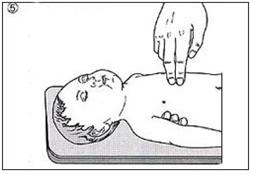
그림 2-102. 처치자의 한쪽 손으로 신생아의 등을 받치고 다른 쪽 손으로 그림과 같이 심장 마사지(심장 압박술)를 할 수 있다.
Use with permission from the Textbook of Neonatal Resuscitation. 1987
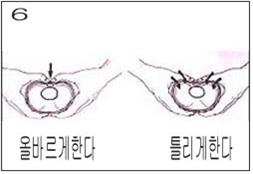
그림 2-103. 심장 마사지를 할 때 위 왼쪽 그림과 같이 등뼈를 향하여 앞가슴을 수직으로 눌러서 심장 마사지를 한다. 오른쪽 그림과 같이 앞가슴을 비스듬히 눌러서(심장 압박 술)는 안 된다
Use with permission from the Textbook of Neonatal Resuscitation. 1987
주: 심장 마사지를 할 때는 항상 인공호흡을 동시에 해야 한다.
① 신생아가 갑자기 숨을 거의 쉬지 못하거나 아주 쉬지 않는 것을 목격했을 때나 심장이 아주 비정상적으로 느리게 뛰거나 멈출 때 인공호흡과 심장 압박 술을 동시 시작해야 한다.
[부모도 반의사가 되어야 한다-소아가정간호백과]-제 1권 소아청소년 응급의료 -신생아의 심폐 소생술 참조.- 우선 앞가슴이나 복부가 숨 쉴 때처럼 움직이나 확인하고 숨소리가 나나 처치자의 귀를 신생아의 입과 코에 댄다.
- 숨결이 뺨에 닿나 알아본다.
- 숨을 쉬지 않으면 공기가 코 구멍에서부터 폐 속까지 유통하게 우선 기도를 열어 준다. 즉 기도를 확보 한다.
- 입안, 콧구멍 속, 비강 속 인두강 속에 있는 분비물, 구토 물, 가래, 이물 등을 손가락으로 후비어 내든지 흡인구 등으로 흡인 제거해서 기도를 통해 공기가 잘 유통하도록 한다.
- 그와 동시에 손목, 팔꿈치 앞 부위, 서혜부, 목 등에서 맥박이 뛰는지 알아본다.
- 심장이나 맥박이 비정상적으로 아주 느리게 뛰거나 또는 아주 뛰지 않고 심장이 정지됐다고 판단이 하면 인공호흡과 심장 마사지를 동시 즉시 시작한다.
- 그렇지만 신생아가 숨 쉬지 못할 때 맥박이나 심장박동이 정상인지 비정상인지 알아보기가 힘들기 때문에 숨을 거의 쉬지 못하거나 아주 쉬지 못하면 인공호흡과 심장 마사지(심장 압박 술)를 동시 시작 하는 것이 보통이다.
② 심장 마사지를 하는 방법은 일령, 월령 나이와 여러 가지 조건에 따라 조금씩 다르다.
갓 태어난 신생아나 그 후 신생아와 영아에게는 다음과 같이 심장 마사지를 한다.
- 신생아나 영아를 단단하고 평평한 자리에 등을 대고 눕힌다(신생아의 심폐 소생술 그림 ① 참조).
- 처치자의 한쪽 엄지손가락 끝 부분을 신생아나 영아의 흉골 아래 ⅓ 부분에 올려놓은 후, 그 엄지손가락의 끝 부분 위에 다른 쪽의 엄지손가락 끝 부분을 올려놓든지(신생아의 심폐 소생술 그림 ②),
- 양쪽 엄지손가락의 끝 부분을 흉골 아래 ⅓ 부위에 나란히 올려놓는다(신생아 심폐 소생술 그림 ③).
- 나머지 양쪽 손의 손가락들과 손바닥으로 신생아의 몸통을 싸잡고 심장 마사지를 하든지, 한쪽 손 집게손가락과 가운뎃손가락 끝 부위를 흉골 아래 ⅓ 부분에 올려놓고 등뼈를 향하여 가슴을 ½∼¾ 인치(갓 태어난 신생아나 영아의 경우),
- 또는 등뼈를 향하여 가슴을 ½∼1인치(1~8세 아이) 눌러 심장 속에 있는 피가 전신으로 흘러가도록 심장 마사지(심장 압박 술)를 한다(신생아 심폐 소생술 그림 ④).
- 심장 마사지를 갓 태어난 신생아나 영아에게 할 때는 1분에 90∼100회 한다. 즉, 심장 마사지를 세 번 한 후 인공호흡을 한 번 한다.
③ 1∼8세 유아나 학령기 아이 또는 그 이상 먹은 학령기 아이에게 심장 마사지를 할 때는 심장 마사지를 하는 사람의 한쪽 손바닥이나 양쪽 손바닥을 아이의 흉골 중간 부분의 바로 아래 부위에 올려놓고 1분에 60∼90번 한다.
④ 2∼2.5초 동안 크게 소리 내어 ‘하나’라고 세면서 첫 번째 심장 마사지를 해 주고, “둘”이라고 소리 내어 세면서 두 번째 심장 마사지를 하고, “셋” 하고 소리를 내면서 세 번째 심장 마사지를 하고, 바로 그 다음 인공호흡을 한 번 한다. 그 다음 또다시 같은 요령으로 2∼2.5초 동안에 하나, 둘, 셋을 전과 같이 세면서 앞에서와 같이 심장 마사지를 연거푸 3번 하고 인공호흡을 한 번 한다.
⑤ 두 사람 이상이 있을 때는 한 사람은 인공호흡을, 다른 사람은 심장 마사지를 한다.
그렇지만 한 사람만 있을 때는, 한 사람이 인공호흡을 하고 심장 마사지를 다 하면서 다른 사람에게 도움을 청한다.
⑥ 평소에 모든 부모는 신생아 및 영유아, 학령기 아이, 사춘기 아이의 소아 기본 심폐소생을 배워야 한다.
그리고 연수교육을 받아야 한다. 일생 동안 한 번도 기본 심폐소생술을 쓸 수 있을지 안 쓸지 몰라도 배워놓는다.
Neonatal cardiopulmonary resuscitation (Neonatal CPR)
Basic CPR, which can resuscitate a newborn who is barely breathing or has sudden cardiac arrest, is described here.

Figure 2-98. When performing CPR on a newborn Perform a cardiac massage (cardiac compression) by pressing your finger on the sternum area. Use with permission from the Textbook of Neonatal Resuscitation. 1987

Figure 2-99. When performing CPR on a newborn baby, lay them on their back on a firm, flat surface. Use with permission from the Textbook of Neonatal Resuscitation. 1987

Figure 2-100. Place both thumbs on the bottom of the baby’s sternum as shown in the picture, or place them side by side and wrap the baby’s torso with the other fingers and do a heart massage (cardiac compression). Use with permission from the Textbook of Neonatal Resuscitation. 1987

Figure 2-101. Place the tip of the index finger and middle finger on the area below the sternum as shown in the figure, and press the newborn’s forearm toward the spine to perform cardiac massage (cardiac compression). Use with permission from the Textbook of Neonatal Resuscitation. 1987

Figure 2-102. As shown, the patient can support the newborn’s back with one hand and perform cardiac massage (cardiac compression) with the other hand. Use with permission from the Textbook of Neonatal Resuscitation. 1987

Figure 2-103. When doing a heart massage, do a heart massage by pressing the front chest vertically toward the spine as shown in the picture on the left above. Do not press the chest at an angle (cardiac compression) as shown in the picture on the right. Use with permission from the Textbook of Neonatal Resuscitation. 1987
Note: When performing cardiac massage, artificial respiration should always be performed simultaneously.
① Simultaneous initiation of artificial respiration and cardiac compression should be initiated when the newborn suddenly notices little or no breathing, or when the heart beats or stops very unusually slowly.
www.drleepediatrics.com – Volume 1 Emergency Medical Care for Children and Adolescents – See Cardiopulmonary Resuscitation for Newborns.
• First, check if the chest or abdomen moves as if breathing, and if there is a sound of breathing, place the operator’s ear to the newborn’s mouth and nose.
• Check to see if the breath is touching your cheek.
• If the newborn is not breathing, open his airways first so that air can flow from his nostrils into your lungs. That is secure prayer.
• Pick up secretions, vomit, sputum, and foreign objects in the mouth, nostrils, and pharynx in the nasal cavity with your fingers or aspirate and remove them with a suction port to ensure good air circulation.
• At the same time, check for pulses in the wrist, front of the elbow, groin, and neck.
• If the heart or pulse is beating abnormally very slowly, or if the heart is not beating very much and it is determined that the heart has stopped, immediately start artificial respiration and cardiac massage at the same time.
• However, when the newborn is not breathing, it is difficult to tell if the pulse or heartbeat is normal or abnormal, so if breathing is barely or very difficult, artificial respiration and cardiac massage (cardiac compression) are usually started at the same time.
② The method of heart massage is slightly different depending on age, the month of age, and various conditions. Cardiac massage for newborns and later newborns and infants as follows.
• Lay the newborn or infant on their back on a firm, flat surface (refer to the newborn cardiopulmonary resuscitation figure ①).
• Place the tip of one thumb of the caregiver on the ⅓ part below the sternum of the newborn or infant, and then place the tip of the other thumb on the tip of the thumb (cardiopulmonary resuscitation for newborn baby ②);
• Place the tips of both thumbs side by side in the ⅓ area below the sternum (CPR for newborns ③).
• Wrap the newborn’s torso with the fingers and palms of both hands and massage the heart, or place the tips of the index and middle fingers of one hand one-third below the sternum and lift the chest ½ to ¾ inches toward the spine of newborns or infants),
• Alternatively, perform a cardiac massage (cardiac compression technique) by pressing the chest ½ to 1 inch (1 to 8 years old) against the spine to allow the blood in the heart to flow throughout the body (cardiopulmonary resuscitation for newborns, figure
• When giving a heart massage to a newborn baby or infant, do it 90 to 100 times per minute. That is, after three cardiac massages, one artificial respiration ④).
③ When giving a heart massage to a 1-8-year-old infant, school-age child, or older child, place one or both palms of the person doing the heart massage on the area just below the middle of the child’s sternum, Do it 90 times.
④ Do the first heart massage while counting “one” out loud for 2 to 2.5 seconds, the second heart massage while counting “two” out loud, and the third heart massage while making a “three” sound, Immediately after that, give one artificial respiration. Then, in the same manner again, for 2 to 2.5 seconds, counting one, two, three as before, perform heart massage three times in succession as before and perform artificial respiration once.
⑤ When there are more than two people, one person performs artificial respiration and the other person performs cardiac massage. However, when there is only one person, one person does artificial respiration and does heart massage, asking the other for help.
⑥ Normally, all parents should learn basic CPR for newborns, infants, school-age children, and adolescents. And you have to get training. You may or may not be able to use basic CPR even once in your life, but you learn.
출처 및 참조문헌
- www.drleepediatrics.com 제1권 소아청소년 응급 의료
- www.drleepediatrics.com 제2권 소아청소년 예방
- www.drleepediatrics.com 제3권 소아청소년 성장 발육 육아
- www.drleepediatrics.com 제4권 모유,모유수유, 이유
- www.drleepediatrics.com 제5권 인공영양, 우유, 이유식, 비타민, 미네랄, 단백질, 탄수화물, 지방
- www.drleepediatrics.com 제6권 신생아 성장 발육 육아 질병
- www.drleepediatrics.com제7권 소아청소년 감염병
- www.drleepediatrics.com제8권 소아청소년 호흡기 질환
- www.drleepediatrics.com제9권 소아청소년 소화기 질환
- www.drleepediatrics.com제10권. 소아청소년 신장 비뇨 생식기 질환
- www.drleepediatrics.com제11권. 소아청소년 심장 혈관계 질환
- www.drleepediatrics.com제12권. 소아청소년 신경 정신 질환, 행동 수면 문제
- www.drleepediatrics.com제13권. 소아청소년 혈액, 림프, 종양 질환
- www.drleepediatrics.com제14권. 소아청소년 내분비, 유전, 염색체, 대사, 희귀병
- www.drleepediatrics.com제15권. 소아청소년 알레르기, 자가 면역질환
- www.drleepediatrics.com제16권. 소아청소년 정형외과 질환
- www.drleepediatrics.com제17권. 소아청소년 피부 질환
- www.drleepediatrics.com제18권. 소아청소년 이비인후(귀 코 인두 후두) 질환
- www.drleepediatrics.com제19권. 소아청소년 안과 (눈)질환
- www.drleepediatrics.com 제20권 소아청소년 이 (치아)질환
- www.drleepediatrics.com 제21권 소아청소년 가정 학교 간호
- www.drleepediatrics.com 제22권 아들 딸 이렇게 사랑해 키우세요
- www.drleepediatrics.com 제23권 사춘기 아이들의 성장 발육 질병
- www.drleepediatrics.com 제24권 소아청소년 성교육
- www.drleepediatrics.com 제25권 임신, 분만, 출산, 신생아 돌보기
- Red book 29th-31st edition 2021
- Nelson Text Book of Pediatrics 19th- 21st Edition
- The Johns Hopkins Hospital, The Harriet Lane Handbook, 22nd edition
- 응급환자관리 정담미디어
-
소아가정간호백과–부모도 반의사가 되어야 한다, 이상원
-
Neonatal Resuscitation American heart Association
-
Neonatology Jeffrey J.Pomerance, C. Joan Richardson
-
Pediatric Resuscitation Pediatric Clinics of North America, Stephen M. Schexnayder, M.D.
-
Pediatric Critical Care, Pediatric Clinics of North America, James P. Orlowski, M.D.
-
Preparation for Birth. Beverly Savage and Dianna Smith
-
Infectious disease of children, Saul Krugman, Samuel L Katz, Ann A. Gershon, Catherine Wilfert
- 소아과학 대한교과서
- Other